
|   |

|   |
Guru Krupa Nrutya Samaroha - Nita Vidyarthi e-mail: nitavidyarthi@gmail.com Photos: Ganesh Sahoo March 8, 2015 Senior Odissi dancer Gayatri Chand, founder/executive trustee of Debaprasad Nrutya Pratisthan, Bhubaneswar, mounted the first Odissi dance festival Guru Krupa Nrutya Samaroha on Feb 16, 2015 at Jayadev Bhawan, Bhubaneswar. Founded in fond memory of her Guru Debaprasad Das, the relatively young charitable institution was registered in February 2014, but has been teaching Odissi in the Debaprasad style since 2010 and earlier. According to Gayatri, the main aim of the organization is to propagate the tradition of her guru by keeping alive his style through perfection of movements and quality teaching, organizing seminars (held recently) and solo performances through festivals, where side by side, Odissi dancers with the styles of other legendary gurus are also presented. The focus of the maiden venture was to provide a platform, project and promote upcoming, budding and reasonably established dancers. Out of six, one each were from Gurus Pankaj Charan Das and Kelucharan Mohapatra style. The rest were naturally of the Debaprasad gharana. The festival was inaugurated by Dr. Minati Mishra, renowned Odissi dancer and former Principal of Utkal Sangeet Mahavidyalaya. In her inaugural address, she encouraged and praised the organization’s effort in spreading traditional Odissi nritya through performance by young talents. She spoke of the greatness of the legendary dancer and teacher Guru Debaprasad Das and his style and referred to him as a sarvagunasampanna (possessing every possible quality), choreographer and a teacher with patience. Gayatri Chand ushered in the performances with her introduction of the purpose and objectives of the festival. The opening presentation was by Gayatri Chand’s disciple Samikshya Pani, a third year engineering student from Bhubaneswar. She began with ‘Ganesh Vandana’ in the Debaprasad Das style in raga Bajrakanti, tala ektali, khemta, tripata and pahapata, choreographed by Sangeeta Dash, sung and set to music by Ramhari Das. After the main Dhyana Shloka, a sabdaswara pata or the rhythmic syllable was used. Samikshya carefully negotiated “Ekadantam Mahakayam Lambodaram Gajaananam” with the rhythm of Dhaneswar Swain and Ramhari’s baritone voice. Her depiction of Gajanana’s consort had clarity and was convincing. The Odia abhinaya “Muhamuhi kishore chandramankura” written by Kavi Gopalkrushna set to raga Bagesree, taal yati was a graceful attempt by the young dancer who naturally needs more training to mature in expressions. The song rendered in two speeds, single and double by Ramhari Das, made the execution pleasing. 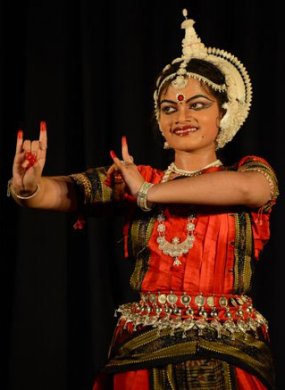 Samikshya Pani 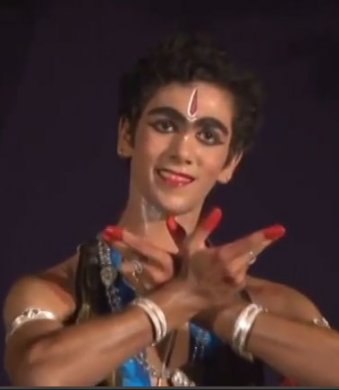 Aneesh Raghavan From Puducherry came a happy dancer Aneesh Raghavan trained by Sangeeta Dash in the Debaprasad style. He showed confidence in the Sthayi Nritya, a pure dance item in raga Sankarabharanam and taal ektali. Though some gurus referred to this segment as Batu Nritya, Guru Debaprasad preferred the name sthayi as it relates more to static points. With the refrain of the sthayi ukuta, Aneesh presented a number of sthayi bhangis or fixed postures of musicians playing different musical instruments like veena, mardal, ginni (cymbals) etc. and also other postures like Alasa (laziness) from the temple sculptures of Odisha. A bit of body balance and tightening of body deflections would do him good. However, the raga Kambodi based Odia abhinaya set to poet Bhagirathi’s beautiful “Mina nayana khina heboni” in ektali was pleasing, supported by the fine lilting melody in the opening line even though his facial expressions remained fixed at times. Dibyashree Panda from Bhubaneswar, trained under Pitambar Biswal, Guru Durga Charan Ranbir’s disciple in the Debaprasad style, presented Asavari Pallavi in ektali displaying good grip over rhythm, smooth circular movements weaving intricate patterns with the music and steadiness in the still points. She proved her training in the abhinaya “Rusana Ramaratana Manamohana” in raga Mishra Kafi set to tala rupak with grace and fluidity. Here is a dancer to watch but her fixed broad smile needs control. 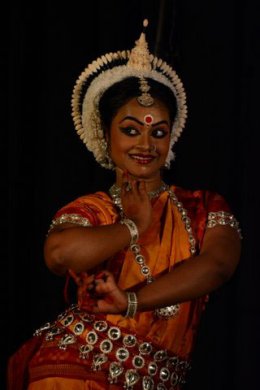 Dibyashree Panda 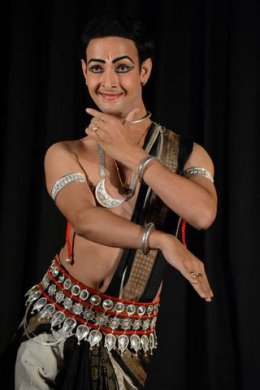 Gouri Shankar Dash Gouri Shankar Dash from Dhenkanal has been trained in the Kelucharan Mohapatra style by gurus Kasturi Pattnaik, Nabakishore Mishra and Bichitrananda Swain and is seen often in dance festivals. His performance of Shankaracharya’s ‘Ardhanariswara’ choreographed by Guru Kelucharan Mohapatra, set to music by Pandit Raghunath Panigrahi in Ragamalika, Talamalika showed clean lines, good stability and strong footwork in the execution of tandava sequences with delicate hastas and charm in the lasya elements. His stretched horizontal movements, clarity of motifs and hastas like “hemangadayai bhujagangadayai” and brisk nritta proved the sincere effort of a dancer in spite of his rather deceiving fragile appearance. Special mention must be made of the experience of hearing duet singing in male and female voices to complement the male and female principles in an Ardhanariswara performance. An astonishing and magical performance was in store for the amazed audience in the form of a sensitive Jayadeva ashtapadi “Sakhi hey keshi mathanamudaram” in raga Pahadi and yati tala, by the deaf and dumb dancer Sakti Swarupa Bir from Bhubaneswar. Trained in the Pankaj Charan Das style by her Guru Chittaranjan Acharya, one of the senior most disciples of Guru Pankaj Charan Das, the 36 year old dance teacher at the Sai International School, learnt Odissi from the age of 7 by relating to the vibrations of the mardala, counting the numbers perhaps and matching her steps with them. An unforgettable abhinaya performed with recorded music for which she needs to look at her Guru’s instructions at the wings, the audience could not expect for more. With live music, she is independent. Sakti Swarupa has proved that sincere effort and will power is always rewarded. It is important to realize here that Sakti’s performance should not be allowed any handicap in praise. Rather, she should be commended for overcoming her challenged condition to be at par with the other dancers with dignity and labour. Sakti has also acted in the Bollywood film ‘Hamari Beti’ which had an entry at the 42nd Chicago International Festival. Gayatri should be lauded for presenting Sakti in her festival. 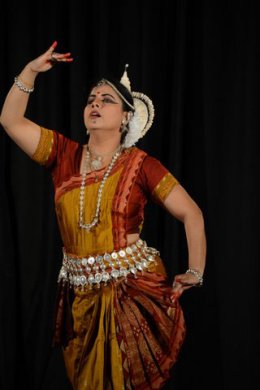 Sakti Swarupa Bir 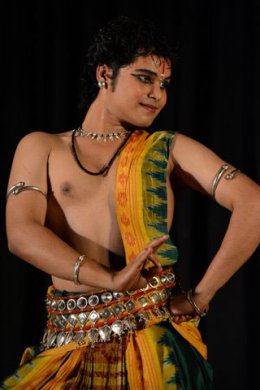 Debasish Pattnaik With his sound training from Kashinath Sahoo and then Durga Charan Ranbir, Debasish Pattnaik from Dhenkanal concluded the festival with a vibrant performance of a pure dance item in Rageshree, Ektaali Pallavi and the ever popular Shivashtakam “Bande Shambhu Umapatim suraguru,” showing sharp control over the intricacies of rhythm and taal in the Pallavi and a good body balance in the Shivashtakam while holding the left leg up and balancing the body on the right. The last shabda after the arasa and the final “Namami Shivam Shiva Kalpataru” worked beyond the conventional movements with stylistic concerns bringing out a strong and fine dancer in Debasish. A lot of hard work has been done by the members of the Pratisthan to organize the festival which showcased talents handpicked by Gayatri Chand with care under the constraint of lean funds and manpower. It is a worthwhile effort and should be made an annual event to make it an ideal platform to project young, dedicated dancers in order to enrich the arena of classical Odissi. The program was compered very ably by Srinibas Ghatuary. Dr. Nita Vidyarthi is a critic of performing arts, specializing in dance, dance theatre and expressions and is a regular contributor to The Hindu, and the Statesman Kolkata in dance, vocal music and theatre. She also contributes to Nartanam, Sruti and narthaki.com. She is trained in Kathak, Bharatanatyam and Manipuri as well as vocal, semi-classical music and Rabindra Sangeet. |